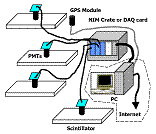Department of Physics and Astronomy: Publications and Other Research

Gregory Snow Publications
Document Type
Article
Date of this Version
9-28-2007
Abstract
Long-lived, heavy particles are predicted in a number of models beyond the standard model of particle physics. We present the first direct search for such particles’ decays, occurring up to 100 h after their production and not synchronized with an accelerator bunch crossing. We apply the analysis to the gluino (g̃), predicted in split supersymmetry, which after hadronization can become charged and lose enough momentum through ionization to come to rest in dense particle detectors. Approximately 410 pb-1 of pp̅ collisions at √s = 1.96 TeV collected with the D0 detector during Run II of the Fermilab Tevatron collider are analyzed in search of such ‘‘stopped gluinos’’ decaying into a gluon and a neutralino (X̃10). Limits are placed on the (gluino cross section) x (probability to stop) x [BR(g̃ → g gX̃10] as a function of the gluino and X̃10 masses, for gluino lifetimes from 30 μs–100 h.


Comments
Published by American Physical Society. Phys. Rev. Lett. 99, 131801 (2007). http://prl.aps.org. Copyright © 2007 American Physical Society. Permission to use.